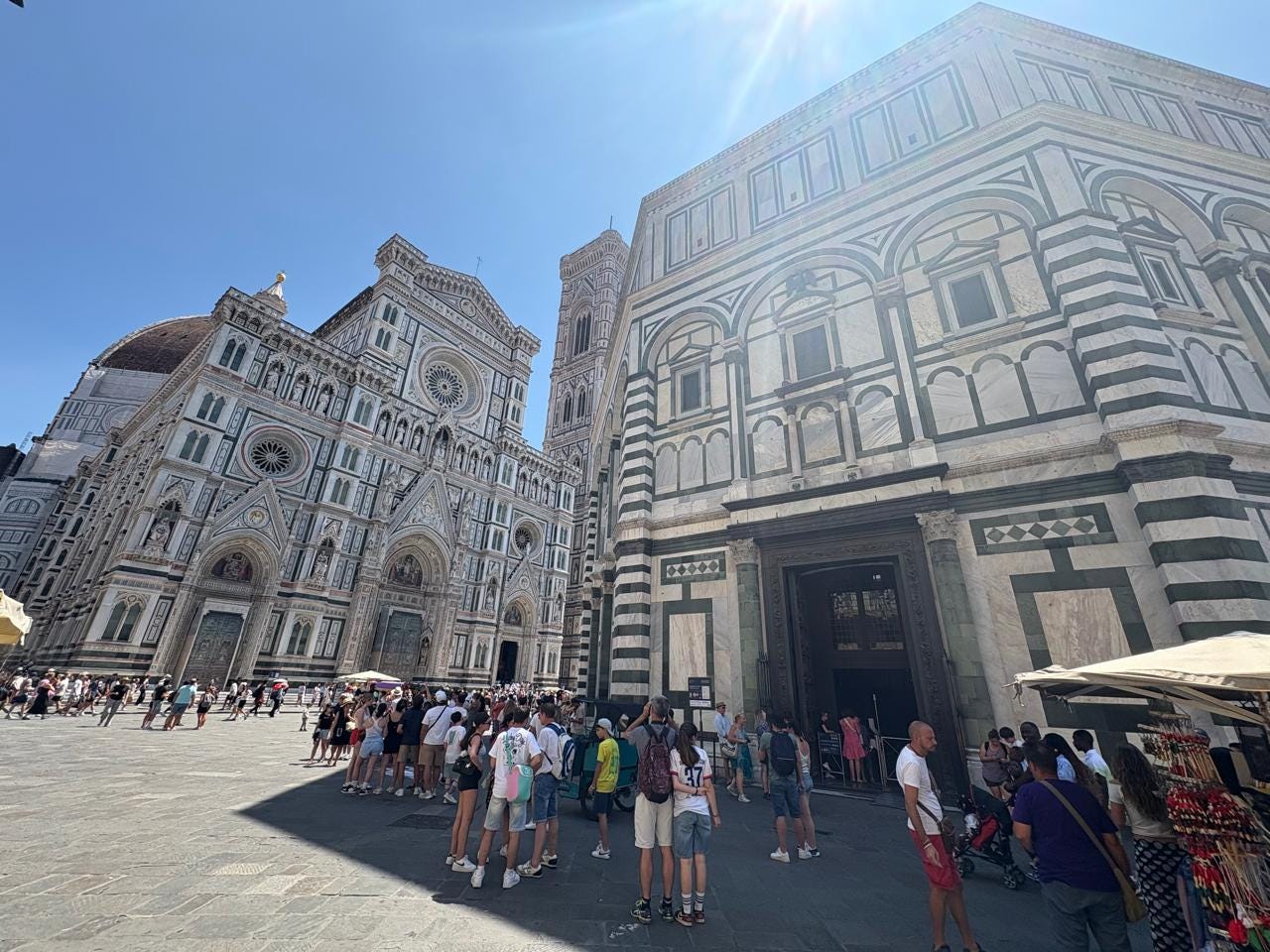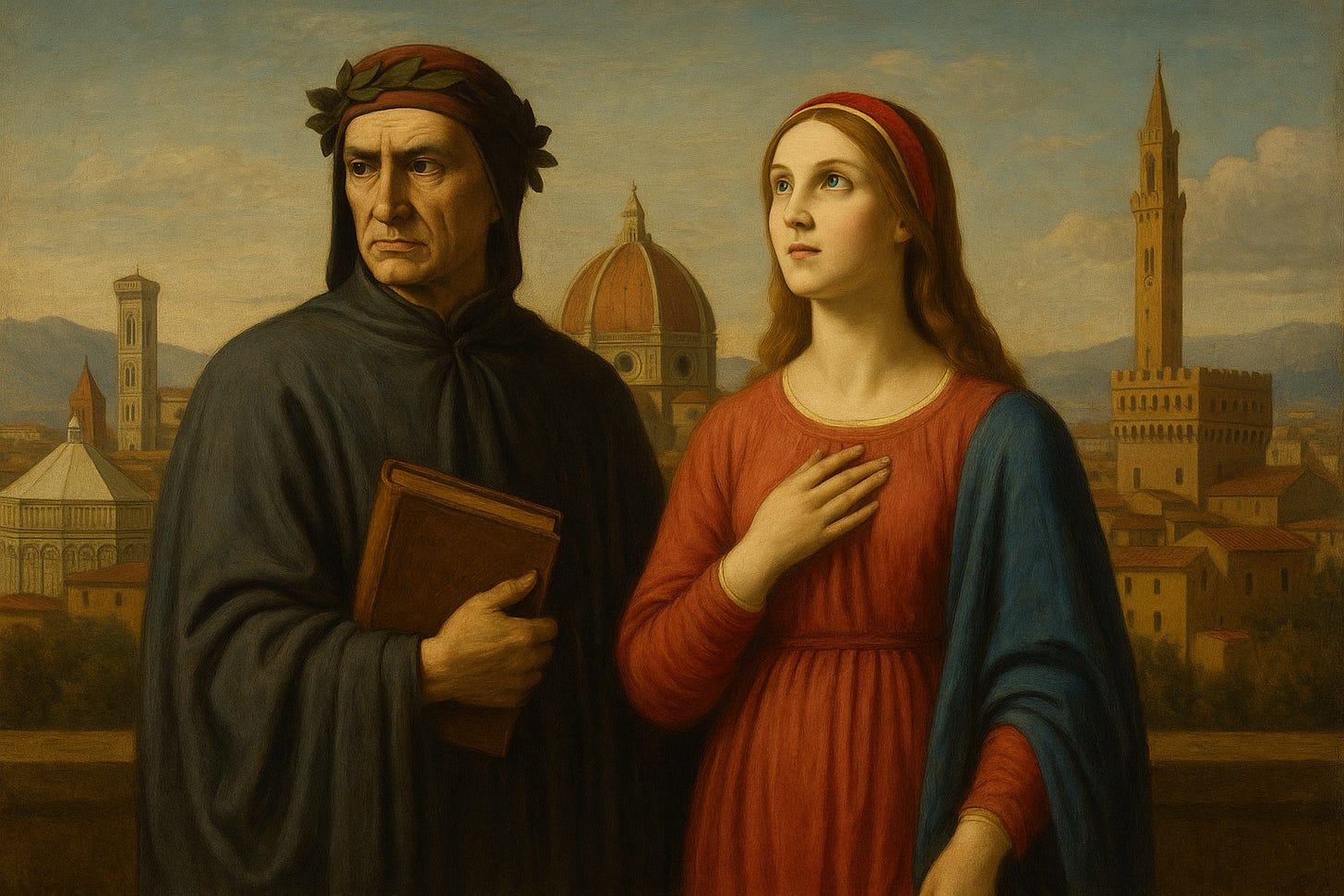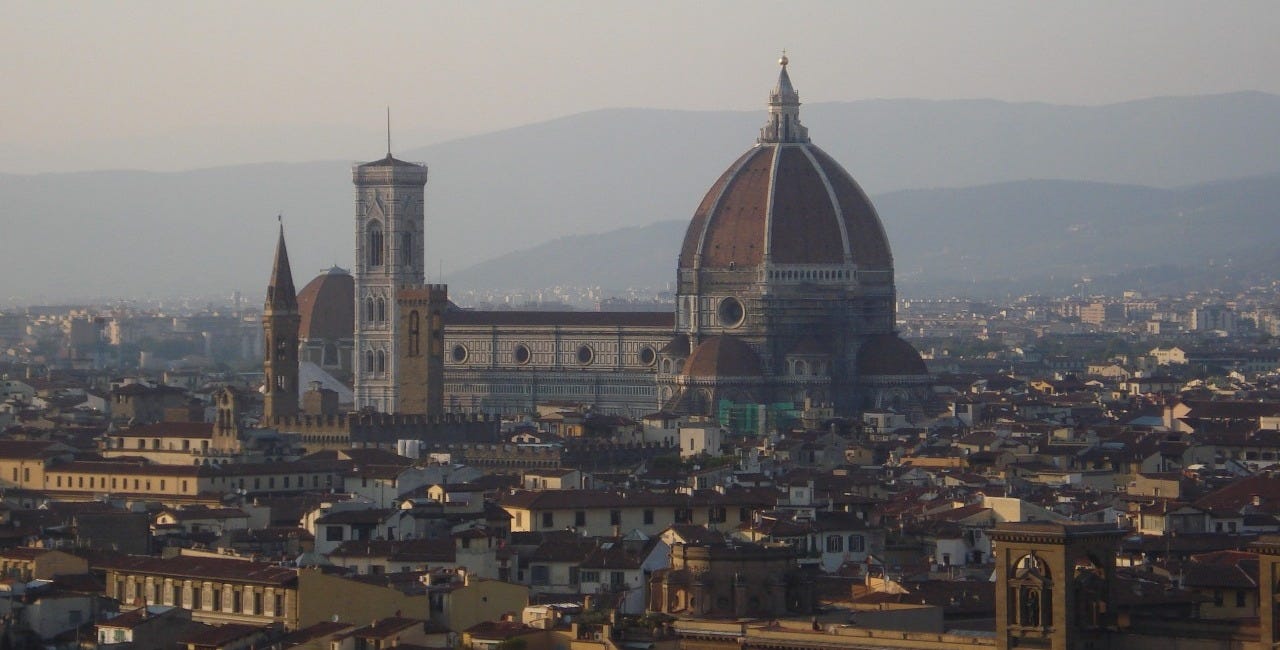Florence is the Beatrice that Transcended the Beauty of Time
The eternal, built by an imperfect society
Florence is the cradle of the Renaissance, attracting millions of tourists each year due to its unique convergence of history, art, architecture, and culture. The revelation of its beauty leaves an indelible impression on those who have had the opportunity to encounter it, and this awe is constantly rekindled by the admiration of new accounts from those currently exploring it.
Its cultural wealth is boundless, born of a fusion of architecture, painting, sculpture, and color accumulated over centuries of continuous refinement and the elevation of a spirit of grandeur. Whether in its architectural masterpieces — the Basilica of Santa Maria Novella, the Baptistery — its museums — such as the Uffizi Gallery — or its sculptures — like Michelangelo’s David — everything composes a scene of splendid admiration and an acclamation of what truly is the beautiful, that superior form of the sensible.

In the foreground of the photograph above, we observe the Baptistery of San Giovanni (11th–13th century), whose 27.4-meter-wide dome is adorned with paintings, frescoes, and mosaics which, according to Judith Dupré, depict “choirs of angels, stories from Genesis, the lives of Joseph, Mary, and Jesus, as well as the life of Saint John, the city’s patron saint.” The sumptuous interior is uniquely complemented by its bronze-carved doors. The south door was sculpted by Andrea Pisano (1330–36), and the north (1402–24) and east (1425–52) doors by Lorenzo Ghiberti. These masterpieces of bronze casting depict various scenes from the New Testament and, as reported in Judith Dupré’s Churches, elicited the following reaction from the genius Michelangelo:
“Oh Divine Work! Oh door worthy of heaven!”
In the middle ground, we see Santa Maria del Fiore, constructed between 1296 and 1436 by various architects, the result of generations of Florentines striving, as Dupré puts it, “to create the largest, most marvelous cathedral in the world.” Its cornerstone was laid “upon a bold structure in which beauty and scale would serve not only as a hymn to God, but also to the ingenuity and discernment of the Florentine people.” Inspired by the form of the neighboring baptistery, a cruciform cathedral was conceived, with an octagonal crossing from which three equally long arms radiate. The exquisite bell tower by Giotto di Bondone has a top resembling that of the nearby Palazzo Vecchio, then the seat of the Florentine communal government, revealing the interconnectedness of Florence’s civic and religious ideals.
Further back in the photograph stands the dome by Filippo Brunelleschi, whose architectural solution earned him immortality. With its base beginning 54 meters above the ground and its height reaching 33 meters, the dome’s very stability was questioned even after construction had begun, to the point that Brunelleschi had to confront opposition directly, even physically, to ensure its continuation. With meticulous care, he oversaw every aspect of the dome’s construction, employing unprecedented techniques drawn from his studies of Roman imperial vaults. The cathedral’s interior, painted by Giorgio Vasari and completed by Federico Zuccari, complements the themes of the Baptistery, echoing the Last Judgment — the largest cycle of Christian frescoes ever created.
In these last paragraphs, I have attempted to describe, in a brief manner and flirting with superficiality, using specialized literature such as the book Churches by Judith Dupré, first to remind those who know these wonders, but also to try to describe, for those who do not, the beauty of a small part of the city.
My intent is to demonstrate the grandeur — which is not possible with such few and feeble words — of works of art that were built over centuries, across generations, resulting in these eternal creations. The goal is to reach a point of reflection, why do we no longer create this kind of expression of the beautiful? Why is the sublime no longer expressed with such sumptuousness?
My first reflection was to link the fading of the beautiful to the process of secularization, whereby moral influence and the education of the individual are shifted from a religious axis to a rational one. Thus, beauty would be the outcome of strong religious influence, to the detriment of reason.
How could we imagine transposing our thinking in order to find justification or understand the reason why the Florentine population was literally able to finance, promote, and construct beauty over so many centuries? How could a society, considered by many modern secular individuals to be backward because it was religious, manage to gift us with such great beauty?
In Florence itself, I believe I have found a point of reflection, drawing from the well of wisdom of a native Florentine, baptized in the Baptistery of San Giovanni, and author of the masterpiece of the Italian language and one of the great works of universal literature, The Divine Comedy by Dante Alighieri.
Throughout his journey, Dante traverses Hell and Purgatory in the company of the poet Virgil, who represents human reason, classical philosophy, and rationality. Alighieri reveals both his unconditional love for Florence and his explicit criticism of its corruption, political divisions, and moral decay — he was exiled from the city in 1302. A critical turning point occurs upon reaching Paradise: there, Dante can no longer be accompanied by Virgil, but only by Beatrice, his beloved, the embodiment of divine beauty. It is she who takes on the role of Dante’s guide toward Paradise.
During the flourishing centuries of Florence, the city was not led by perfect people. Whether in the political divisions of Dante’s time between the Guelphs and Ghibellines (late 13th and early 14th centuries), or after Dante’s life during the rise of the Medici (late 14th and early 15th centuries), the beauty of the city was built amid a flawed society — Dante criticizes those who accumulate wealth out of vanity or who corrupt society. But it was this flawed society that financed, through the commune of Florence, the guilds, and wealthy families, with greater or lesser importance depending on the economic cycles, the construction of beauty for eternity. Whether these works were built out of devotion, ambition, or the pursuit of prestige matters little, for it was a long-term vision that made possible the creation of a work of enduring greatness.
In today’s secular process, the absence of a narrative of eternity, combined with individualism, a focus on the ephemeral, and cultural fragmentation, redirects wealth toward other ends, often more practical, but less tangible or aesthetically enduring. A striking contrast is that even a secularized society continues to seek transcendent beauty, as evidenced by the millions of tourists who come to Florence each year. These secular individuals seek beauty in Florence, and unconsciously the transcendence of Beatrice.
This realization only reinforces the timelessness of the classics; they are not bound to the era in which they were written. Reason alone may guide us through hell and purgatory, as Virgil guided Dante — but only Beatrice — the beauty can lead us toward transcendence, toward the human capacity to go beyond our limitations. From the narrow secular point of view, of those in whom reason overrides the transcendent, Florence was the result of a short-sighted vision of a deeply religious society, yet these same people seek in Florence the harmony that defies time — the city that transcended its era.
The Florentines were not shortsighted because they were religious — they were rational — and through that quality they crossed the hell and purgatory of an imperfect society, transcending into eternal beauty, an achievement that today’s society does not seem to come close to matching. Are we still capable of building not just what endures, but what transcends?

This essay was originally published in Portuguese on July 19, 2025. You can read the original version here:
Florença, a Beatriz que Transcendeu o Tempo.
Florença é o berço do Renascimento e atrai milhões de turistas anualmente em razão de sua ímpar conjunção de história, arte, arquitetura e cultura. A revelação de sua beleza é uma indelével lembrança para quem já teve a oportunidade de conhecê-la e é sempre reavivada pela admiração de novos relatos daqueles que estão a explorá-la atualmente.
Explore more translations in our English Essays section.








